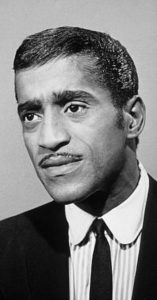
Sammy Davis Jr.
This date marks the birth of Sammy Davis, Jr. in 1925. He was a Black impressionist, actor, singer, and dancer.
Sammy Davis, Jr., was born in Harlem, New York City, into show business to Elvera Sanchez, a chorus girl, and Sam Davis, Sr., the lead dancer in a vaudeville revue called Will Mastin's Holiday in Dixieland. Davis began in vaudeville in that show at the age of 3. In 1931, he appeared in the Ethel Waters film "Rufus Jones For President."
In 1932, his uncle's act was renamed the Will Mastin Trio, and Davis, who learned to tap dance from Bill "Bojangles" Robinson, soon became the act's star. Davis went solo in the early 1950s and made his first mark with an album, "Starring Sammy Davis Jr.," that mimicked other singers. Though not a jazz singer per se, Davis could play trumpet and vibes and occasionally subbed on drums in the Woody Herman and Lionel Hampton bands.
In 1954, Davis lost an eye in a car accident, and his eye patch became a stage signature. His first hit was "Hey There," followed by "Something's Gotta Give," "Love Me Or Leave Me," and "That Old Black Magic." He debuted on Broadway in "Mr. Wonderful" and played Sportin' Life in the film "Porgy and Bess." In the 1960s, Davis appeared with Sinatra and Martin in the "Rat Pack" films "Oceans Eleven" and "Robin and The Seven Hoods." Davis sold a million records in 1962 with "What Kind of Fool Am I." In 1988, he made a film with Gregory Hines named "Tap."
In 1970, he married Altovise Gore, and the couple adopted one child. Davis was among the first Black performers to be accepted into the American mainstream, and he made this acceptance the subject of much of his stage persona. Sammy Davis Jr. died in 1990.
The African American Desk Reference
Schomburg Center for Research in Black Culture
Copyright 1999 The Stonesong Press Inc. and
The New York Public Library, John Wiley & Sons, Inc. Pub.
ISBN 0-471-23924-0